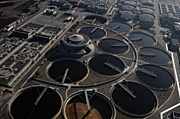

Several individuals, organizations and I have been involved in Fats, Oil & Grease (FOG) control and regulation over the last 30 months or so. While it has been a challenging and interesting period, the state of Ohio's enforcement and adopting agencies, such as the Ohio EPA (OEPA) and the Department of Commerce's Board of Building Standards (BBS), seem to be in a "fog"

With EPA rules and regulations in place (the published exemption from a PTI requirement), the POWTWs must accept their portion of responsibility for protecting our environment and the public's welfare. This can be done by implementing requirements on FOG discharge levels, monitoring, record keeping and penalties for violating the rules.
Every commercial property should be equipped with a means to monitor the sewage, including FOG, discharging from facilities on that property. The type and method of monitoring the sewage effluent discharge might vary between POWTWs, but a manhole located at or near the property line can serve that purpose. The manhole would permit the POWTW to sample the effluent or place monitoring equipment at any time with or without the commercial operator's consent or knowledge. This would allow the POWTW to verify compliance with the established levels of discharge and determine those that might violate the rules.
As with any regulation, the POWTW must establish a penalty structure for enforcement of the FOG requirements. Penalties could consist of a warning for a first violation, and a monetary fine for a second violation within a specified period of the previous offense. Should violations continue, the monetary penalty should increase, or as a last resort, utility service to the property should be terminated.
The type of equipment/device, the process and location should be left to the design professionals. A professional engineer, the engineer-in-charge, who seals the construction documents, is responsible and liable for the overall design of the plumbing system, including any grease interceptors.
Each of the parties involved in the FOG issue needs to cooperate and work together to eliminate FOG contamination/pollution from entering the environment inappropriately. We must each operate within our areas of expertise. The EPA protects the environment and public good, regulating those that discharge processed effluent into that environment. POWTWs that permit effluent into their treatment and transport systems must develop reasonable rules and regulations concerning FOG. Design and standards should be left to design professionals recognized by the state and code communities.
FOG is a growing problem for the environment, EPA, POWTWs, design professionals, manufacturers, commercial enterprises and many others. Provided the interested parties cooperate and work together, the problem can be reduced and managed.

